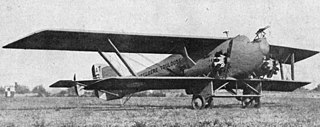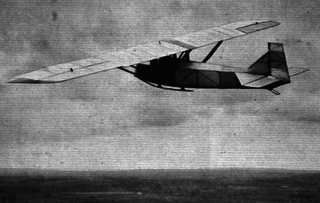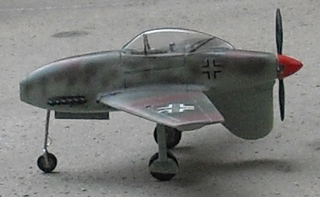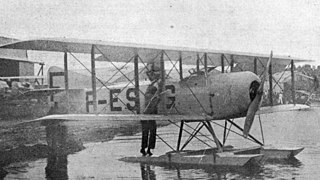
Pterodactyl was the name given to a series of experimental tailless aircraft designs developed by G. T. R. Hill in the 1920s and early 1930s. Named after the genus Pterodactylus, a well-known type of Pterosaur commonly known as the pterodactyl, all but the first were produced by Westland Aircraft Ltd after Hill joined them.

The Latécoère 6 was a French four-engined biplane bomber of the early 1920s. It was of advanced all-metal construction and probably the first aircraft to use geodetic construction. Only one was built.

The Gwinn Aircar was a single-engined biplane with a cabin for two, designed in the US as a safe and simple private aircraft. Lacking a rudder, it had several unusual control features as well as an early tricycle undercarriage. Development was abandoned after a crash in 1938.
The Teichfuss Cicogna was an Italian tailless single-seat motor glider designed by Luigi Teichfuss and flown in 1936.
The RRG Professor was a very early soaring glider and the first to use a variometer for finding thermals. It was designed by Alexander Lippisch in Germany, first flying in 1928. The Professor was widely built by both flying clubs and factories.
The RRG Urubu Obs, often known just as the RRG Obs, was a one-off, large, two or three seat glider designed for meteorological observations by Alexander Lippisch in Germany and first flown in 1932.

The RRG Falke of 1930 was a secondary training glider designed by Alexander Lippisch in Germany and intended to provide better performance than his earlier RRG Prüfling whilst being easier to fly because of its inherent stability. It was sold as plans for both club and commercial production and was built in Germany and abroad.

The 1926 German RRG Prüfling of 1926 was a secondary training glider designed for club use. Plans were sold and it was built in Germany and across the world.
The Potez 26 was a single seat fighter aircraft designed and flown in France in the mid-1920s. It did not reach production.

The Messerschmitt Me 334 was a proposed German piston-engined fighter, designed by Alexander Lippisch. No examples were built.

The Caudron C.65 was a single seat biplane floatplane designed and built in France in 1922. Only one was completed.

The Caudron Type O was a French single seat air racing biplane first flown in 1914.

The Villiers IV or Villiers 4 was a French two seat naval floatplane. Two were built, the first with twin floats and the second with one. The first was short-lived but the second set several world and national records; it later became the Villiers XI.

The Lioré et Olivier H-23-2 was an amphibious maritime reconnaissance flying boat, built in France in 1932. Three were produced for the Venezuelan Army Air Service.

The Dewoitine D.480 was a French single engine side-by-side sports and training aircraft built in the early 1930s. Two were completed and flew with several different radial engines. One remained active through the 1950s.

The CAMS 80 was an amphibious reconnaissance flying boat flown in the early 1930s. Two were built with different engines and were used by the Aéronavale for VIP transport and equipment development until 1938.
The Caproni Ca.66 was an Italian night bomber designed to reequip the post-World War I Italian Air Force. Only two examples of the four-engined biplane were built.

The Kharkiv KhAI-4 was an experimental Soviet tailless aircraft tested in 1934. It only made three flights before being grounded as dangerous.
The RRG Delta I was a German experimental tailless aircraft flown in the early 1930s first as a glider and then powered. It was one of the first delta wing aircraft.

The Politechnika Warszawska PW-4 Pelikan was a motor-glider variant of the two seat Polish PW-3 Bakcyl glider. Only one flew.















